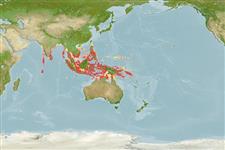Actinopterygii (peixes com raios nas barbatanas) >
Perciformes (Perch-likes) >
Lutjanidae (Snappers) > Lutjaninae
Etymology: Lutjanus: Malay, ikan lutjan, name of a fish.
Ambiente / Clima / Intervalo
Ecologia
; marinhas associadas(os) a recifes; intervalo de profundidade 3 - 36 m (Ref. 9710). Tropical, preferred ?; 23°N - 14°S, 71°E - 165°E (Ref. 55)
Indo-Pacific: mainly the Indo-Australian Archipelago from the Solomon Islands to Sumatra, and from off Cape York Peninsula, Australia, northward to the Philippines; also occurring in the central and eastern Indian Ocean as far west as Maldives.
Tamanho / Peso / Idade
Maturity: Lm ? range ? - ? cm
Max length : 25.0 cm TL macho/indeterminado; (Ref. 48635); common length : 15.0 cm TL macho/indeterminado; (Ref. 55)
Espinhos dorsais (total): 11; Raios dorsais moles (total): 12; Espinhos anais 3; Raios anais moles: 8. Snout profile low, sloping very gently. Preorbital bone narrow, its width less than half of eye diameter. Preopercular notch and knob poorly developed. Scale rows on back rising obliquely above lateral line. Generally dark brown of the upper part of the head and body with a broad white horizontal band immediately below. The lower part of the head and body dusky brown with a suffusion of yellow. A pair of white spots is on the back just below the dorsal fin base (Ref. 469).
Adults inhabit coral reefs (Ref. 9710, 48635) and outer reef slopes (Ref. 37816, 48635). They sometimes form large schools of more than 100 individuals. Often solitary (Ref. 48635). Feed mainly on small fishes and crustaceans. Generally uncommon (Ref. 9710).
Life cycle and mating behavior
Maturidade | Reprodução | Desova | Ovos | Fecundidade | Larvas
Allen, G.R., 1985. FAO Species Catalogue. Vol. 6. Snappers of the world. An annotated and illustrated catalogue of lutjanid species known to date. FAO Fish. Synop. 125(6):208 p. Rome: FAO. (Ref. 55)
Categoria na Lista Vermelha da IUCN (Ref. 115185)
CITES (Ref. 94142)
Not Evaluated
Ameaça para o homem
Harmless
Utilização humana
Pescarias: espécies comerciais
Mais informação
Nomes comunsSinónimosMetabolismoPredadoresEcotoxicologiaReproduçãoMaturidadeDesovaFecundidadeOvosDesenvolvimento dos ovos
ReferênciasAquaculturaPerfil para aquaculturaEstirpesGenéticaFrequência dos alelosHereditariedadeDoençasProcessamentoMass conversion
ColaboradoresFotografiasStamps, CoinsSonsCiguateraVelocidadeTipo de nataçãoÁrea branquialOutras referênciasCérebrosVisão
Ferramentas
Relatórios especiais
Descarregue XML
Fontes da internet
Estimates of some properties based on models
Phylogenetic diversity index (Ref.
82805): PD
50 = 0.5000 [Uniqueness, from 0.5 = low to 2.0 = high].
Bayesian length-weight: a=0.01445 (0.00705 - 0.02962), b=2.98 (2.82 - 3.14), in cm Total Length, based on LWR estimates for this Genus-body shape (Ref.
93245).
Nível Trófico (Ref.
69278): 4.0 ±0.65 se; Based on food items.
Resiliência (Ref.
69278): Elevada, tempo mínimo de duplicação da população menor que 15 meses (Preliminary K or Fecundity.).
Vulnerabilidade (Ref.
59153): Low vulnerability (24 of 100) .
